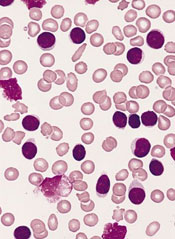
The European Medicines Agency (EMA) has granted orphan drug designation for selinexor (KPT-330) to treat multiple myeloma (MM) and chronic lymphocytic leukemia (CLL)/small lymphocytic lymphoma (SLL), including Richter’s transformation.
Selinexor previously received orphan designation from both the EMA and the US Food and Drug Administration to treat patients with acute myeloid leukemia and those with diffuse large B-cell lymphoma.
Orphan designation is granted to promote the development of drugs that target rare, life-threatening or debilitating conditions and are expected to provide a significant therapeutic advantage over existing treatments.
Orphan designation qualifies a company—in this case, Karyopharm Therapeutics Inc.—for benefits that include targeted scientific advice from the EMA regarding drug development and 10 years of market exclusivity following the drug’s approval.
About selinexor
Selinexor (KPT-330) is a first-in-class, oral selective inhibitor of nuclear export (SINE) compound. Selinexor functions by inhibiting the nuclear export protein XPO1 (also called CRM1).
This leads to the accumulation of tumor suppressor proteins in the cell nucleus, which subsequently reinitiates and amplifies their tumor suppressor function. This is thought to prompt apoptosis in cancer cells while largely sparing normal cells.
Selinexor has shown promise in an ongoing phase 1 study of patients with a range of hematologic malignancies. Results of this trial were presented at the 2014 ASCO Annual Meeting.
At that point, the study included 51 patients who had received selinexor across 8 dose levels, ranging from 3 mg/m2 to 60 mg/m2.
Among the 43 patients evaluable for response, the overall response rate was 28%, and the complete response rate was 5%.
Most adverse events were gastrointestinal in nature, and most of them were grade 1 or 2. The most common adverse events were nausea, anorexia, and fatigue.
There were 3 dose-limiting toxicities, including 1 MM patient with grade 4 thrombocytopenia, 1 follicular lymphoma patient with grade 4 thrombocytopenia, and 1 CLL patient with grade 2 fatigue.

